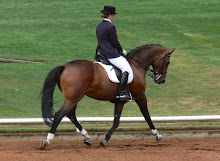Last weekend I audited a clinic with one of the world's top dressage riders and trainers: Jan Brink from Sweden. The clinic was held at KGF Equestrian Center in Kirkland, Washington, and hosted by Steinberg-Bryant Dressage. One of Jan's big themes throughout the weekend was adjustability in the horses. Interestingly, he thought that 35 years ago the emphasis in dressage was on big, ground covering gaits, but he feels that now it is much more important to be able to vary the gaits smoothly and quickly. He further discussed what he called the three "control points":
1) The Track--the rider needs to be able to control the relative alignment of the horse's front legs and hind legs
2) The Rhythm--the rider needs to be able to speed up or slow down the horse's rhythm while maintaining the same stride length
3) The Strides--the rider needs to be able to ride longer strides or shorter strides while maintaining the same rhythm
Jan feels that riders should not wait too long to start varying the strides with young horses, even three and four year old horses. With the very young horse, riding longer and shorter strides has nothing to with collection but it is in the direction of collection. In fact, with the young horse it is helpful to think to ride longer strides, but then back to the normal stride as the young horse is not strong enough to really do shorter strides. He also had the riders ride a 20m circle in the canter with longer strides, then riding a smaller circle (15 or 12m) when riding coming back to the normal stride length which encourages the horse to come back.
Adjusting control point #2 is a little more confusing (at least for me!). Jan used the analogy of a basketball player dribbling a basketball. The ball can be dribbled quicker or slower without making it move more forward. This ability to change the rhythm but keep the stride length the same is very helpful when teaching flying changes, as the horses need to "bounce" more off the ground in a quicker beat to get the change. He had several of the riders just ride on a 20 meter circle, find a baseline rhythm in the canter for instance, and then practice just changing the rhythm to quicker or slower steps.
To really test control point #1, Jan had the riders ride often on the centerline. With the young horses it is enough just to try to ride straight down the centerline! On the older horses the riders could ride shoulder-in or travers on the center line to really test their ability to control the shoulders and haunches.
As the work became more advanced Jan would have the riders combining the three control points and emphasizing different elements, depending on the strengths and weaknesses of the horse and rider. For instance, in training the pirouettes, Jan would have the riders ride travers in the canter on a 15 meter circle. Within that movement, the riders were to quicken the horse's rhythm. When the riders had a good feeling, they could then change to riding a 12m circle, or 10m circle or down to a 6m circle, but always the rider needs to stay disciplined about the circle line. It was a good "bodybuilding" exercise and an excellent exercise to train the horse to balance and wait during the pirouette canter.
Jan was great at explaining both the more general issues, and then applying these general points to the individual horse/rider combination to help improve specific aspects of their performance. All in all, a very good clinic!
Tuesday, January 18, 2011
Subscribe to:
Post Comments (Atom)

No comments:
Post a Comment